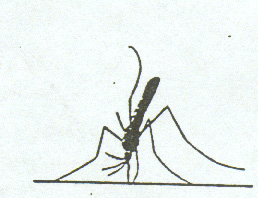
Background for the Article by A. C. Allison (1954)
Protection Afforded by Sickle Cell Trait Against Subtertian Malarial Infection
British Medical Journal 1, 290 - 294

Background for the Article by A. C. Allison (1954)
Protection Afforded by Sickle Cell Trait Against Subtertian Malarial Infection
British Medical Journal 1, 290 - 294
Background
Diggs et al.(1) combined their data with those of others and demonstrated that between 7 and 8% of the African American population had the sickle-cell trait. When the genetic relationship between sickle-cell trait and sickle-cell anemia became clear, population biologists were confronted with a dilemma. How could a gene, apparently so detrimental in homozygous state, be present at such high frequencies? One would expect that natural selection acting through the reduced fitness of homozygous individuals (sickle-cell anemia) would reduce the frequency of the sickle-cell gene to low levels over many generations. In order to explain the "high" frequency of the sickle-cell-gene, natural selection must favor it in some way in heterozygous individuals. In other words the heterozygous carriers who have the trait must have a fitness greater than both "normals" and people with sickle-cell anemia. J. B. S. Haldane, biochemist, evolutionary biologist, geneticist, and coauthor of one of the articles in the course reader, is attributed with suggesting a connection between the sickle cell gene and malaria. At the VIII International Congress of Genetics in 1949, he said,
"The corpuscles of the anaerobic heterozygote are smaller than normal, and more resistant to hypotonic solution. It is at least conceivable that they are also more resistant to attacks by the sporozoa that cause malaria."In evolutionary biology, scientists first try to identify environmental factors that correlate with a particular characteristic. Because the sickle-cell gene occurs almost exclusively among blacks in the United States, the selective agent was sought in Africa and other tropical areas where the gene occurs. Allison discovered a suggestive correlation between the frequency of the sickle-cell gene (up to 40%) and the prevalence of malaria (2), a disease caused by a protozoan parasite that attacks red blood cells (3) and is transmitted by certain mosquitoes (4). Malaria today kills between one and two million people world wide each year. Over 200 million new cases occur each year (only about 1000 in the USA). It is the kind of selective agent that could maintain high frequencies of the sickle-cell gene. However, correlation is different than cause. Allison, therefore, designed an experiment to test the hypothesis that carriers of the sickle-cell gene have increased resistance to malaria. He describes that experiment, its results, and his conclusions in the article you are about to read.
Dr. Anthony C.
Allison in 2003.
|
Students in
CHEM-342 in the spring of 2003 had the opportunity to meet Dr. Allison
in person when he visited the class and and discussed the context of
his classic article showing that people with sickle cell trait have
increased resistance to malaria. Dr. Allison lives in California. He
published a reflective autobiographical article about that research in
2002 (5).
Malaria continues to be a major world health problem. There are probably 100 million people at this moment who are clinically ill from the disease! Unfortunately, the parasites are becoming resistant to the drugs used to prevent and control it and the mosquitoes are often resistant to insecticides that have been effective for years. As a consequence, there has been a raging controversy about whether to bring back DDT to control the mosquitoes that transmit malaria. The biochemistry of red blood cells, malaria parasites, mosquitoes, and the human immune response represent important areas of current research (6 - 13). |
References
2. Allison, A. C. (1956) Sickle Cells and Evolution, Scientific American 195(Aug), 87 - 94.
3. Wyler, D. J. (1993) Malaria: Overview and Update, Clin. Infectious Disease 16, 449 - 458. (This is an up-to-date description of the causes, diagnosis, and treatment of malaria.)
4. Ross, E. S. and Roberts, H. R. (1943) Mosquito Atlas Part I - The Nearctic Anopheles: Important Malaria Vectors of the Americas and Aëdes aegypti, Culex quinquefasciatus. 44 pp.; Part II - Eighteen Old World Anophelines Important to Malaria. 44 pp. Pub. by The American Entomological Society, Philadelphia. (Everything you ever might want to know about the identification of mosquitoes that transmit malaria. This was an important document for US troops in tropical areas during World War II.)
5. Allikson, Anthony C. (2002) The
discovery of resistance to malaria of sickle cell heterozygotes. Biochemistry and Molecular Biology
Education 30(5),
279-287.
6. Marshall, E. (1990) Malaria Research - What Next? Science 247, 399 - 402.
7. Cherfas, J. (1990) Malaria Vaccines - The Failed Promise. Science 247, 402 - 403.
8. Goldberg, D. E., Slater, A. F. G., Cerami, A., and Henderson, G. B. (1990) Hemoglobin degradation in the malaria parasite Plasmodium falciparum: An ordered process in a unique organelle, Proc. Natl. Acad. Sci. USA 87, 2931 - 2935.
9. Adams, J. H., Sim, B. K. L., Dolan, S. A., Fang, X., Kaslow, D. C., and Miller, L. H. (1992) A family of erythrocyte binding proteins of the malaria parasite, Proc. Natl. Acad. Sci. USA 89, 7085 - 7089.
10. Miller, L. H. (1992) The Challenge of Malaria, Science 257, 36 - 37.
11. Wellems, T. E. (1992) How Chloroquine Works, Nature 355, 108 - 109.
12. Hoffman, S. L., Nussenzweig, V., Sadoff, J. C., and Nussenzweig, R. S. (1991) Progress Toward Malaria Preerythrocytic Vaccines, Science 252, 520 - 521.
13. Godson, G. N. (1985) Molecular Approaches to Malaria Vaccines, Scientific American (May 1985).